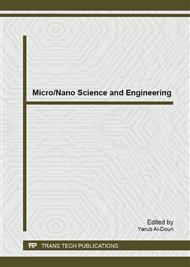[1]
A. Fujishima, K. Honda, Electrochemical photolysis of water at a semiconductor electrode, Nature 238 (1972) 37-38.
DOI: 10.1038/238037a0
Google Scholar
[2]
O. Khaselev, J.A. Turner, A monolithic photovoltaic- photoelectrochemical device for hydrogen production via water splitting, Science 280 (1998) 425-427.
DOI: 10.1126/science.280.5362.425
Google Scholar
[3]
M. Ashokkumar, An overview on semiconductor particulate systems for photoproduction of hydrogen, Int. J. Hydrogen Energy 23 (1998) 427-438.
DOI: 10.1016/s0360-3199(97)00103-1
Google Scholar
[4]
C.T. Kresge, M.E. Leonowicz, W.J. Roth, J.C. Vartuli, J.S. Beck, Ordered mesoporous molecular sieves synthesized by a liquid-crystal template mechanism, Nature 359 (1992) 710-712.
DOI: 10.1038/359710a0
Google Scholar
[5]
R. Ryoo, S.H. Joo, S. Jun, Synthesis of highly ordered carbon molecular sieves via template-mediated structural transformation, J. Phys. Chem. B 103 (1999) 7743-7746.
DOI: 10.1021/jp991673a
Google Scholar
[6]
Q.S. Huo, D.I. Margolese, U. Ciesla, P.Y. Feng, T.E. Gier, P. Sieger, R. Leon, P.M. Petroff, F. Schuth, G.D. Stucky, Generalized synthesis of periodic surfactant/inorganic composite materials, Nature 368 (1994) 317-321.
DOI: 10.1038/368317a0
Google Scholar
[7]
M. Ni, M.K.H. Leung, D.Y.C. Leung, K. Sumathy, A review and recent developments in photocatalytic water-splitting using TiO2 for hydrogen production, Renew. Sust. Energ. Rev. 11 (2007) 401-425.
DOI: 10.1016/j.rser.2005.01.009
Google Scholar
[8]
] O.M. Alfano, D. Bahnemann, A.E. Cassano, R. Dillert, R. Goslich, Photocatalysis in water environments using artificial and solar light, Catal. Today 58 (2000) 199-230.
DOI: 10.1016/s0920-5861(00)00252-2
Google Scholar
[9]
D.M. Antonelli, J.Y. Ying, Synthesis of hexagonally packed mesoporous TiO2 by a modified sol–gel method, Angew. Chem. -Int. Ed. Engl. 34 (1995) 2014-(2017).
DOI: 10.1002/anie.199520141
Google Scholar
[10]
D.M. Antonelli, Synthesis of phosphorous-free mesoporous titania via templating with amine surfactants, Micropor. Mesopor. Mater. 30 (1999) 315-319.
DOI: 10.1016/s1387-1811(99)00042-6
Google Scholar
[11]
D.T. On, A Simple Route for the Synthesis of mesostructured lamellar and hexagonal phosphorus-free titania (TiO2), Langmuir 15 (1999) 8561-8564.
DOI: 10.1021/la9905463
Google Scholar
[12]
C.J. Brinker, Y.F. Lu, A. Sellinger, H.Y. Fan, Evaporation-induced self-assembly: nanostructures made easy, Adv. Mater. 11 (1999) 579.
DOI: 10.1002/(sici)1521-4095(199905)11:7<579::aid-adma579>3.0.co;2-r
Google Scholar
[13]
B.Z. Tian, H.F. Yang, X.Y. Liu, S.H. Xie, C.Z. Yu, J. Fan, B. Tu, D.Y. Zhao, Fast preparation of highly ordered nonsiliceous mesoporous materials via mixed inorganic precursors , Chem. Commun. (2002) 1824-1825.
DOI: 10.1039/b205006d
Google Scholar
[14]
G. Soler-Illia, A. Louis, C. Sanchez, Synthesis and characterization of mesostructured titania-based materials through evaporation-induced self-assembly, Chem. Mater. 14 (2002)750-759.
DOI: 10.1021/cm011217a
Google Scholar
[15]
A. Khanal, Y. Inoue, M. Yada, and K. Nakashima, Synthesis of silica hollow nanoparticles templated by polymeric micelle with core−shell−corona structure, J. Am. Chem. Soc. 129 (2007) 1534-1535.
DOI: 10.1021/ja0684904
Google Scholar
[16]
R. Zhang, A. A. Elzatahry, S. S. Al-Deyab, D. Zhao, Mesoporous titania: from synthesis to application, Nano Today 7(2012) , 344-366.
DOI: 10.1016/j.nantod.2012.06.012
Google Scholar
[17]
M. Gratzel, The advent of mesoscopic injection solar cells , Prog. Photovoltaics 14 (2006) 429-442.
DOI: 10.1002/pip.712
Google Scholar


